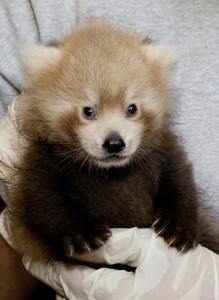It was a dark and stormy night…

One of two red pandas born at the Smithsonian Conservation Biology Institute in Front Royal, Va., June 5, 2011. (Photo by Mehgan Murphy)
Thunder, lightning and strong winds greeted the National Zoo’s two female red panda cubs when they were born June 17, and that stormy night has now determined their names. One cub, Pili, received her name Sept. 22 after voting closed on NBC Washington’s website. Pili, which means “clap of thunder” in Chinese, was the winner among four names—all storm-related—with 30 percent of the vote. A Zoo supporter named Pili’s twin sister Damini, which is Nepalese for “lightning.”
Red pandas are native to the cool, temperate bamboo forests of Bhutan, China, India, Myanmar and Nepal. They have long, sharp claws and a reddish coat with white markings, which helps them blend in with the red mosses and white lichens that grow on the trees in which they live. Red pandas are listed as vulnerable by the International Union for Conservation of Nature as the result of habitat loss and poaching. Only about 2,500 adult red pandas remain in the wild.
Red panda enthusiasts can watch both cubs and their parents, Shama and Tate, on the Zoo’s red panda webcam.

Conservation Biology Institute in Front Royal, Va., June 5, 2011. Keeper Jessica Kordell holds the cub.(Photo by Mehgan Murphy)
Posted: 26 September 2011
- Categories:



